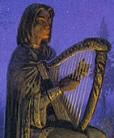b. Pronunciation Guide
The following sample words offer a rough example of what the correct Elvish pronunciations should sound like. They help eliminate the most basic mistakes made by English speakers, such as pronouncing ‘Oromë’ as ‘oh-row-mea’, ‘Aulë’ as ‘all-lay’, or Númenor as ‘New-menor’. Especially with the vowels, however, the proper Elvish sound differs somewhat from that in the sample words below; it is usually more precise and well-formed, never reduced as in English. For the precise Elvish pronunciation, please see either the CoE pronunciation guides for Elvish, or another reliable source with more detailed information on the sounds.
VOWELS
A – as in ‘run’ [in the SSG usually marked ‘ah’]
Á – as in ‘card’ [in the SSG usually marked ‘aa’]
 – held somewhat longer than Á (never as in ‘ale’)
E – as in ‘set’ [in the SSG usually marked ‘eh’]
É – as in ‘there’
final Ë – always pronounced; as in ‘set’ (never as in ‘café’); like E above in sound- the diaeresis merely marks it’s not silent.
I – as in ‘sin’ [in the SSG sometimes marked ‘ih’ to avoid pronouncing the I as in the pronoun ‘I’]
Í – as in ‘machine’
Î – held somewhat longer than Í (never as in the pronoun ‘I’)
O – as in ‘dot’ (in Oxford pronunciation)
Ó – as in ‘lord’
Ô – held somewhat longer than Ó (never as in ‘go’)
U – as in ‘bull’ [in the SSG usually marked ‘oo’ to avoid pronouncing the U as the one in ‘up’]
Ú – as in ‘mood’
Û – held somewhat longer than Ú; as in ‘nazgûl’ (never as ‘you’)
VOWEL DIPHTHONGS & CLUSTERS
note: the use of diaeresis (¨) in one of the pair merely marks its reading as separate vowel, and disyllabicity of the combination.
AI – as ‘eye’
AE – can be pronounced as ‘AI’ above
AU – as in ‘town’
EI – as in ‘grey’
EA/EÄ/ËA – both vowels pronounced: eh-ah (never as in ‘fear’, ‘dead’, or ‘bear’)
EO/EÖ/ËO – both vowels pronounced: eh-oh, as in ‘Éowyn’ (never as in ‘Leo’ or ‘leopard’)
note: for initial IA, IE, IO, see Consonants.
IA/ÍA – both vowels pronounced: ih-ah, as in ‘see art’ (never as in ‘dial’)
IE/IË – both vowels pronounced: ih-eh, as in ‘she-elf’ (never as in ‘friend’ or ‘fiery’)
IO – both vowels pronounced: ih-oh, as in ‘be off’ (never as in ‘riot’)
OI – as in ‘boy’
OE – can be pronounced as ‘OI’ above
UA – as in ‘drew art’ (never beginning as in ‘you’)
UI – as in ‘ruin’
UO – as in ‘shoo off’ (never beginning as in ‘you’)
CONSONANTS & CONSONANT CLUSTERS
C – as in ‘calm’ (never as in ‘cell’)
G – as in ‘get’ (never as in ‘gentle’)
H – as in ‘house’, except for HY (see HY) and a few other combinations.
I (in initial IA-, IE-, IO-) – as in ‘yard’ (IA), ‘yes’ (IE), ‘your’ (IO)
R – trilled in all positions as in Spanish.
S – as in ‘sell’, never the ‘z’ sound as in ‘is all’.
CH – as in the Scottish ‘loch’ (never as in ‘church’)
DH – as in ‘then’
HY – as in ‘hew’ (never as in ‘hyena’)
TH – as in ‘thin’
PH – read as F
NG – as in ‘finger’ except in final position where it’s as in ‘sing’.
Stress:
(taken from the Sindarin workbook here on CoE)
– In a word with two syllables, stress always falls on the first syllable.
– In longer words, it falls on the second to last syllable when the second to last syllable contains a long vowel, a diphthong, or a vowel followed by two (or more) consonants.
– When the second to last syllable contains a short vowel followed by only one (or no) consonant, the stress falls on the syllable before it, the third from the last.










2 Comments
I found this very helpful.
I think I can speak better now
THX